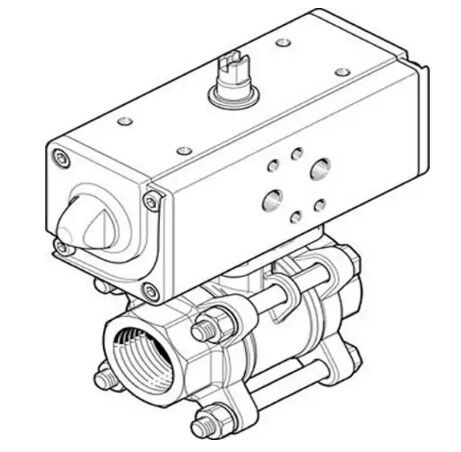Fire Resistance Strategies for Industrial Control Valves
On this page
Control valves play a crucial role in various industrial applications, especially in high-temperature and fire environments, where ensuring their fire resistance is key. Although different fire resistance standards and testing methods may vary, a comprehensive approach should be taken to safeguard the fire resistance performance of control valves.
The fire resistance performance of control valves in fire environments is vital. To ensure that control valves remain operational and sealed under fire conditions, the valve body must meet the following fire resistance requirements.
During a fire, the valve plug and seat of the control valve should maintain good metal-to-metal contact. This means that even under extremely high temperatures, regardless of changes in the sealing structure, spring force, or external pressure, this contact point should remain stable. Ensuring the stability of metal-to-metal contact is key to the valve's precise closure and effective sealing. This stability prevents seal failure due to material thermal expansion or deformation at high temperatures.
To reduce external leakage during a fire, the control valve body should take the following measures: adopt valve stem sealing materials with excellent fire resistance. These materials should withstand high temperatures and not easily fail, maintaining the valve's sealing integrity. Avoid using large gasket-style valve body connections, as these may leak at high temperatures. Using compact connections or valve body structures designed for fire resistance helps reduce the risk of leakage.
The control valve body must have sufficient resistance to deformation to ensure normal operation in the high-temperature environment after a fire. The materials and design of the valve should withstand the high temperatures caused by a fire without significant deformation or performance degradation. This requires:
Using high-temperature-resistant materials: Manufacture the valve body with materials that can withstand high temperatures, such as fire-resistant alloys or high-temperature steels.
Strengthening the valve body structure: Design considerations should account for potential thermal expansion and stress distribution to ensure the valve body does not lose structural strength or function at high temperatures.
To enhance the fire resistance performance of control valves under fire conditions and ensure their normal operation during a fire, effective fire protection measures are necessary.
Some manufacturers have attempted to isolate control valves from external heat sources by wrapping multiple layers of felt covers or constructing enclosures with fire-resistant materials. However, these methods often have limited effectiveness in practical applications because they require disassembly and reinstallation during each maintenance, and due to the limitations of valve installation locations, these methods may not be applicable.
A more effective fire protection method currently in use is the application of fire-resistant bags. Made of multiple layers of ceramic or glass fiber, these bags are secured with nylon ties and fixed to the device with stainless steel wire coated with ethylene resin. These bags can be quickly fitted in a few minutes and are easy to remove during maintenance. Tested to withstand a 2000°F flame for 30 minutes, the valves still maintain performance, demonstrating satisfactory results.
The fire-resistant design of the control valve's actuator under fire conditions is key to ensuring the system's normal operation in extreme high-temperature environments. Effective fire-resistant design not only protects the functionality of the valve but also enhances system safety. The main considerations and methods for the fire-resistant design of actuators are as follows.
To ensure that control valves can be promptly closed during a fire, spring-loaded pneumatic diaphragm actuators are commonly chosen. This design takes advantage of the low melting point of the diaphragm, which quickly fails in a fire, allowing the spring to move and keep the valve closed. Additionally, heat-sensitive fusible plugs can be used to reduce the pressure of the pneumatic system, especially suitable for piston-type reciprocating spring actuators.
A fire may alter the properties of metal parts, such as making metals softer or causing them to melt. The spring force is directly related to the tempering characteristics, so whether the remaining spring force after a fire is sufficient to maintain the valve's position needs to be verified through combustion tests for its effectiveness.
Butterfly Control Valves: After combustion, butterfly control valves require the remaining spring torque to maintain the valve's closed position. The force required for closure is usually much less than the original output force of the actuator.
Ball Control Valves: Under the same pipeline pressure, balanced ball control valves require less spring force than unbalanced ball control valves. Therefore, in fire-prone situations, balanced ball control valves are more favored.
To protect springs from the annealing effects of flames, the following three methods can be adopted:
Insulating Materials: Use insulating materials, insulating covers, or fire-resistant bags to ensure that the actuator can operate normally for half an hour after a fire. These methods are effective but may be bulky and space-consuming.
Sprinklers: Installing sprinklers on top of the actuator can effectively reduce temperature but will increase installation and maintenance costs, and may face the risk of water shortage during a fire.
Fire-Resistant Coating: Use an epoxy-based thin layer coating to protect the actuator, allowing it to operate normally during a fire. This method provides effective protection but requires regular inspection and maintenance of the coating's integrity.
The fire resistance performance of control valves is key to ensuring their reliable operation in extreme environments. By comprehensively applying fire-resistant bags, the design of spring-loaded pneumatic diaphragm actuators, and effective protective measures, the reliability and safety of control valves under fire conditions can be significantly improved. These measures not only help reduce the impact of fires on equipment but also maintain the normal operation of the system at critical moments.

